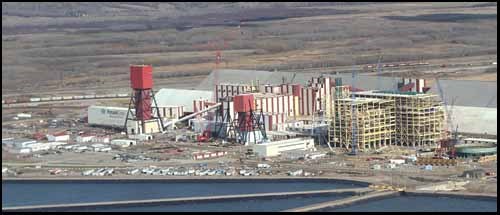An economic impact study by the Saskatchewan East Enterprise Region (SEER) has offered details on the potential effects of potash development on the region's economy and infrastructure.
Derek Murray, the study's author, presented his 60-page report to members of the public in Moosomin on January 23 and in Melville on January 24.
A number of major potash expansion and exploration projects are currently underway in the region. The Mosaic mine at Esterhazy, already the largest potash mining operation in the world, is in the midst of growth plans that will double its workforce in the next decade. PotashCorp's Rocanville mine, too, is in the midst of expansion. Exploration is in progress near Melville, Bredenbury, Muskowekwan First Nation, and Foam Lake by companies such as BHP Billiton, Encanta Potash, and North Atlantic Potash.
If even a few of these projects are seen to completion, the economic benefits to the region will be immense; so too will be the pressure placed on existing infrastructure.
The economic impact study commissioned by SEER contained no surprises for the organization, said CEO Kim Wondrasek.
"We knew already that our rental accommodations are low, our housing is in need of development, and that labor was definitely an issue. It was great to see all of that in the impact study just to really solidify that data so we could take it forth to the communities."
The report predicts a net gain of about 1,500 jobs from the two projects officially confirmed and underway in the region, the expansions at Mosaic's Esterhazy site and PotashCorp's Rocanville site. It is unknown how many of the other proposed projects will proceed, but using what the study's author considers a "reasonable" expectation of two major mining projects within SEER's borders and a third just outside its western border within the next five to ten years, the report predicts a total gain of about 3,700 new jobs, or a doubling of current potash-related employment. About a third of those positions would be direct employment in the mining industry, while the other two thirds would be in related industries.
But many of those jobs could be left unfilled or lost to other regions if private and public organizations here are slow to remove barriers to immigration and employment. The region is still in "a catch-up position from years of slow economic growth," suggests the report, with a lack of general infrastructure, office space, shopping facilities, transportation, and educational opportunities.
There has been little investment in rental apartments in the region since the 1960s and 70s, writes the author, and the vacancy rate in Yorkton is already just 2.5 percent. Communities closest to mine sites, such as Esterhazy, will face strains on not just their housing, but their school capacities as well.
SEER's low labor force participation rate (66.7 percent) compared to the rest of the province is another indication that fully capturing these economic opportunities will be a challenge. This statistic, says the report, indicates that "the region's skill set is not matched with employment growth in the area."
Higher participation rates, higher educational attainment, substantial national and international migration, and increased Aboriginal labor force participation will all be needed to meet the demand, writes Murray.
The region's Aboriginal population-12 percent today, expected to reach 22 percent by 2035-represents one of the largest and most promising untapped labor pools. But education is a significant barrier; less than half of the current Aboriginal population has a Grade 12 education. Training opportunities in the trades are also still lacking in the region, suggests the report.
Possible solutions to these and other problems are underway. Parkland College, for example, provides post-secondary education to large numbers of Aboriginal residents each year, and has plans to build a major Trades and Technology Centre in Yorkton in the near future.
Another essential step will be getting word out to the region's young people who have tended to look elsewhere for employment, said Wondrasek.
"Especially with our students that are currently in the region, both in high schools and post-secondary such as Parkland College-we want to let them know about the opportunities that are coming and the need for training and skilled training."
For the part of the municipalities, Wondrasek said that they need to focus on building infrastructure that attracts members of the 20-to-44-year-old demographic that will be taking on most of the coming jobs.
"Those are the ones that are the long terms that we can train and retain. They're going to move here and build a foundation for their families, raise their kids."
With the right preparations and attitude, the South East Enterprise Region can probably retain about 80 percent of the employment impact from the next decade's potash development, proposes Murray in the study.
"It's exciting times for our region," said Wondrasek.


.png;w=120;h=80;mode=crop)

